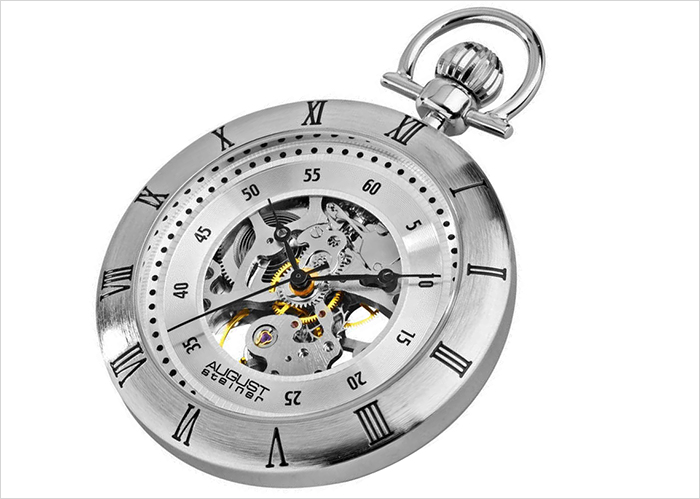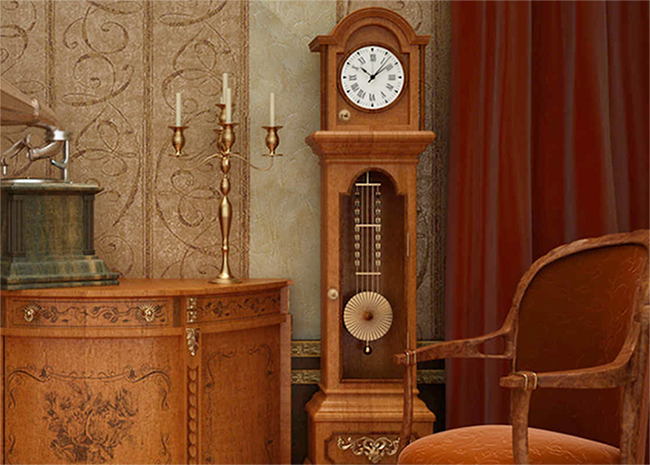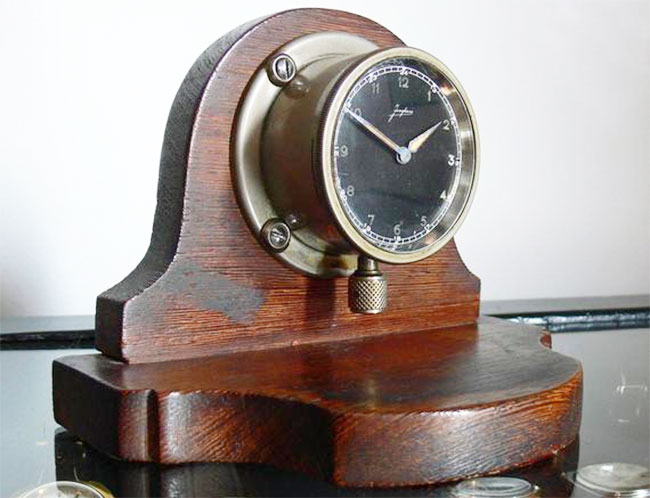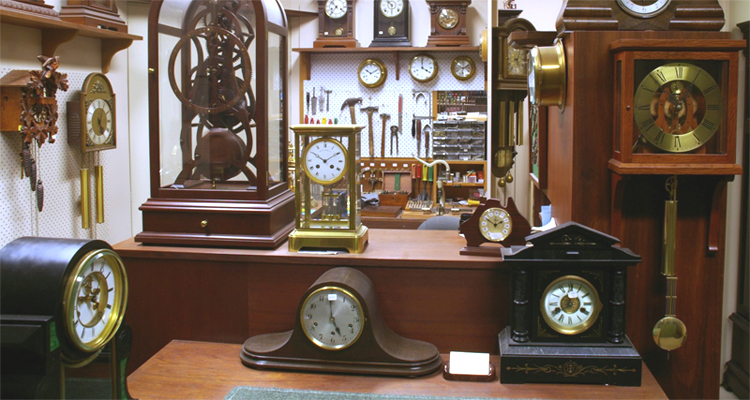Antique clocks are one of the most widespread collectible items that even collectors of this age and era still sought after. The passion for these antiques continues to dominate even with the rise of today’s mechanical and technological leaps that concerns clocks as well.
The art of clock making in the earlier centuries proved to be a very recognized skill. As such, the clocks of those days were highly elaborate and intricate and much more precise compared to what we have today.
Old clocks came in steady pace that created a wide variety of antique clock styles, types, and designs.
These are the general types of antique clocks (please find out more info below):
Antique Lantern clocks
This is the oldest form of collectible clock you can find. Its name was taken from the word latten, meaning brass which became the lantern clock’s standard material.
Lantern clocks originated in 1500 but only became popular in the 16th century resembling candle lamps. They became obsolete in the 1800’s. Earliest forms of antique lantern clocks were weight driven and run for about 12 hours before it needs to be rewound which is about 2 or 3 times a day.
Antique lantern clocks were not perfectly accurate; they commonly lose or gain about 10 to 15 minutes daily. A common feature of lantern clocks is its alarm function which is done and set by turning a small dial inside the main dial.
Antique Mantel clocks
Throughout the years, antique mantel clocks have become one of the most celebrated of all clocks. They are inexpensive which makes them affordable to the majority of the population thus contributed much to their demand.
The first mantle clocks were made in France, dating back around 1750 to 1760 developed from French Regency Bracket clocks. With this basis, old mantel clocks therefore look similar to bracket clocks but are generally smaller.
English mantel clocks soon followed about 10 years later. The mass production of mantel clocks started in early 19th century by clockmaker Eli Terry.
Mantel clocks are highly decorative timepieces and are typically made from combinations of porcelain, wood, and ormolu. The movements are mostly of either brass or wood and can run from 30 hours to 8 days between windings.
It’s a commonplace to set mantle clocks on a mantelpiece, so they’re named, but you can also place them on a shelf and above the fireplace.
Antique Bracket clocks
The earliest forms of bracket clocks were made around 1658 in Holland, reaching the peak of their development in England. They are so called bracket clocks because they had to be mounted on a bracket on the wall to give room for their hanging weights.
Antique bracket clocks are often housed in a rectangular case and were done in ebony finish with side pillars and a pediment on top; later pieces were stained black or ebonized, the pillars were removed and a domed top replaced the pediment and was added a carrying handle.
Bracket clocks drive their mechanism by relying on a coiled spring with a short pendulum instead of a long weighted one thus they are also referred to as spring clocks.
Dutch bracket clocks – known as Haagse. It has a velvet-covered rectangular dial with chapter ring and spandrels. This kind of bracket clock is usually hung on the wall by 2 iron loops attached to the back board.
French bracket clocks – called pendules religieuses. They are close replicas of their Dutch counterpart. Their movement is normally placed in the front case, the bezels of the dial doors are hinged on the left.
English bracket clocks – fine examples include the Regency and Victorian bracket clocks which are sought after collectibles because of the quality of their movements. They first appeared in 1600s and continued production until the mid-19th century where it was disrupted due to World War I.
Antique Longcase clocks
An antique long case clock is apparently the best known of all the antique and old clocks. Longcase clocks are more commonly known in the US as tall case clocks. It is also called grandmother, granddaughter and grandfather clock which can be discerned by the difference in their sizes.
English clockmaker William Clement first produced long case clocks in 1670. These tall and elegant timepieces became status symbols in the old days, accessible only by the well-to-do families. They are treasured heirlooms passed on from one generation to the other.
They are tall, free standing clocks best known for their swinging pendulums and hourly chimes. A typical long case clock stands 6 to 8 feet high with a tall, narrow case and a wide clock face.
The case of a grandfather clock heightens is popularity. It houses their weights and the pendulum. It is made up of a variety of wood such as walnut, oak, and mahogany and lacquered in remarkable, unique, and intricate inlays.
Tall case clocks are classified into 2; the comtoise and the bornholm grandfather clocks. The former can be recognized by its potbelly case and predominantly curved designs.
Grandfather clocks are kept working due to a mechanism of movements supplied by large weights inside its case. They can either run for 30-hours or 8-days before it needs to be rewound.
Antique Carriage clocks
Carriage clocks are developed in the early 19th century in Austria. They were mainly made by the French throughout the 1800s gaining popularity all over England in the 19th century.
These old carriage clocks are spring driven and small which makes them ideal for traveling, thus they are designed for.
Antique carriage clocks are valued treasures that have surpassed the test of time because of their durability and charm that stood elegantly still despite the development of today’s modern mechanical timepieces.
Rare carriage clocks are very expensive and it continues to gain value as it becomes older. They are sought after and preferred by antique clocks collectors because of their size and reasonable cost.
They can be usually identified by these certain characteristics; their case is commonly constructed from brass or other bright metal, the clock face is covered in glass, and the hands are placed on porcelain background to make them clearly visible.
Playing of chimes, songs, or an assortment of notes and chords is how carriage clocks mark their hour. Classic carriage clocks are famously collected for their elaborate attributes such as inlaid gemstones, porcelain and other precious and intricate constructions.
A leather or wooden carry case protects a carriage clock as it is carried around by its owner. The leather protected carriage clocks is rarer than its wooden counterpart because most of them has been decayed by time.
Antique Wall clocks
Named for its obvious purpose, a wall clock is a clock type that its case is devised to be mounted on a wall.
The largest category of antique clocks is represented by wall clocks, and not only that, they too are among the oldest forms clocks designed particularly for home use. The first forms of antique wall clocks were made in the late 1700’s in England and its first true depiction was the round dial clock.
The first few vintage wall clocks were the 18th century France cartel (French for frame) clocks.
English wall clocks are spring driven with verge escapement; by late 1700’s they were replaced by the more credible anchor escapement that requires the use of a longer pendulum thus the wall clock cases were made longer to fit them. By the end of 1700’s, the Americans started producing wall clocks in large numbers.
Antique wall clocks are very much in demand in the old times due to the fact that people believed them to be made of the best quality, mainly because they are hand made. Their superiority is evident among old wall clocks that still functions superbly despite the test of time.
Because of the wall clocks popularity and appeal, various types of clocks were made to fall under it including:
• Old cuckoo clocks – were created by Franz Anton Ketterer in 1730. It is so named because of the sound it generates to strike the hour. Every hour, a door on the clock opens and a figurine comes out as a cuckoo sound is made which is equivalent to the time of the day.
Winding of antique cuckoo clocks has to be done daily, but there are some that can last up to 8 days without doing so.
There are 2 distinct types of cuckoo clocks, the musical and the non-musical cuckoo clock. The musical ones include a melody after the cuckoo and have 3 weights while the non-musical only has 2.
• Old wag-on-the-wall clocks – a popular kind of wall clock that has its weights and pendulum hanging below it.
• Old regulator wall clocks – looks just like a grandfather clock but are much accurate.
They are usually fitted with a dead-beat or gravity escapement with a pendulum that is temperature compensated. This kind of pendulum beats the rate thru a temperature range.
Antique regulator wall clocks are also referred to as pendulum clocks and were invented late in the 18th century.
• Old banjo clocks – patented in 1802 by Aaron and Simon Willard. Antique banjo clocks were originally called “improved timepiece” which is so called because its form is similar to the musical instrument, banjo.
Banjo clocks have 8-day movements. They were able to maintain fame for 60 years until 1860.
When they were no longer in demand and their production completely stopped, making 19th century original banjo clocks highly prized by antique clocks collectors.
• Old mission clocks – also called arts and crafts clocks. Antique mission clocks debuted in the late 1900’s which reflected the aesthetics of those day’s furniture styles.
Mission clocks were basic and simple with functional designs. They are commonly made up of oak on flat surfaces with clean square and rectangular lines.
Antique Advertising clocks
Advertising clocks are obviously advertising and promotional timepieces. They are made in a wide variety of materials and styles to fit and justify whatever they are designed to promote.
Early forms of advertising clocks were elaborately designed and carved wooden clocks. It was a clever strategy to utilize antique advertising clocks to further attract buyers and possible clients.
Sidney Clock Advertising Co. and Baird Clock Co. were 2 of 19th century’s top clock making companies that dominated the advertising clock market.
Antique Anniversary clocks
An anniversary clock is the first mechanical clock that needs not to be wind daily. It is then referred to as a 400-day clock which means that it can reach a year before you wind it again.
Vintage anniversary clocks were made as early as the 17th century. An American inventor patented a torsion pendulum in 1829, a special type of pendulum that required very little power thus made 400-day clock feasible.
By 1904, the term anniversary clock was copyrighted by an American importer who promoted the clock as a gift idea. The clock was endorsed to be wound on the date of an anniversary such as wedding, birthday, or any other yearly event which is utmost fitting.
Most antique anniversary clocks are table top clocks placed in a glass case that allows the inner workings to be visible thru the glass. They are commonly made up of brass, glass, and crystal.
Antique Art Deco clocks
1920 and 1930 witnessed the influence of Art Deco, an international aesthetics movement that inspired the designs of the majority of objects, furniture, and even clocks.
Art Deco clocks mimic the geometric architecture that befits the fast-paced industrial age. Antique Art Deco clocks boasts of serious designs and architectures.
Leading makers of Art Deco clocks includes the French and the Swiss. Their versions feature Roman numerals on the clock face and columns on each side of the timepiece.
Retro clocks
The 50’s, 60’s, and 70’s we’re years of highly fashionable designs. Clocks never made an exception; they too followed the trend and were styled to serve not only as a time teller but as finishing touches to the modern contemporary home.
Retro designs inspired clockmakers to add modern touches to the traditional clock forms. It was incorporated on to the majority of clock types where the most favored are retro alarm clocks, wall clocks and mantel clocks.
Prevailing retro clocks include the Metamec clocks that popularized the sunburst clock. The sunray clock was a favorite as well; it was an improved adaptation of the pre-war Art Deco styled clocks.
Antique Marine chronometer
Marine chronometers were first developed in the 18th century. Also called ship, sea, and sometimes nautical clocks, they were considered as a major technical achievement and one of the most ingenious inventions, considering the need for time on long periods at sea.
The creation of the first ship clock was made possible by John Harrison which took him 31 years to finally produce one. It is the first precise instrument that can determine the distance between 2 locations.
Antique marine chronometers are special timepieces that were constructed to function well even when turned upside down or while its being moved around and even during the worst storms at sea.
This is because of a coiled spring that replaced the pendulum thus not needing steady flat surfaces to tell precise time and will only loose few seconds in a month. Sea clocks are built from brass parts and require no oil. It can resist temperature and humidity changes.
Antique 24 – Hour clocks
The 24-hour clock is basically a 1 day clock that runs from midnight to midnight and is numbered from 0 to 23.
This kind of time system spans several fields and is referred to in many ways. In the United States, it is called the military or the astronomical time. 24–Hour clocks are also called the railway time or the continental time in other countries.
Certain areas of studies also utilize its genius. In medicine, 24-hour clocks are use to document a patient’s medical history. The military started using this kind of notation in the late 1917.
The field of science has also found great favor in this timepiece as navigators, astronomers, scientists, and even horologists too use the 24-hour system.
Antique Skeleton clocks
Antique skeleton clocks first came out in the late 18th and early 19th century giving emphasis to their movements by literally showing them thus becoming a decorative object in itself.
Any form of clock or timepiece in which the parts that are supposedly concealed have been modified and removed to significantly display the inner mechanism is considered as a skeleton clock.
Majority of its main clock parts are openly visible. Its plates are narrow to make the movement easily seen and intentionally expose its various gears, wheels and springs. The escapement, balance wheel and escapements, even the tourbillion can also be visible as well.
Because their parts are exposed, skeleton clocks are usually protected with a glass dome.
Antique Mystery clocks
Mystery clocks are rare and sought after timepieces by antique clock collectors. They are puzzling clocks that appeals to the majority of early mechanical automata aficionados.
It is dubbed as an “impossible clock” because at first glance, you would rather think it doesn’t work, considering that there is no obvious connection between its mechanism and the hands. This is because its method of operation is hidden and difficult to recognize.
Antique mystery clocks dates back from the middle of 19th century. Their clock hands are often enclosed in clear substance such as crystal which then appears to have no contact with its own mechanism.
Antique Kitchen clocks
Kitchen clocks are inexpensive clocks; it’s an American style shelf clock that commonly sits in the kitchens of lower and middle class homes.
Old kitchen clocks were produced in great numbers by the last quarter of the 19th century. They were used to keep and track accurate time for meal preparations or simply serve as a delightful addition to the kitchen.
They are usually constructed from either oak or walnut. Antique kitchen clocks are also called gingerbread clocks due to their press-molded and incise wings and tops making them highly decorative.
Kitchen clocks now have several versions depending on its material, size, and form which range from cartoon characters, objects, celebrities, and other whimsical and unique representations.
Antique Atmos clocks
Changes in atmospheric pressure and temperature allow an atmos clock to continue working without winding. This gives power to the clock’s movement, making it run for long periods of time without human intervention.
Cornelis Drebbel invented the first clock to be powered by changes in the atmosphere and temperature in the early 17th century. However, it was Jean-Léon Reutter who designed the first atmos clock in 1928.
It is unofficially known as Atmos 0 and was driven by a mercury-in-glass expansion device which solely operates on temperature changes in the environment.
An antique atmos clock is powered by a tightly sealed capsule which contains a mixture of gas and liquid ethyl chloride. As the temperature rise, the mixture builds up into an expansion chamber which then compresses a spiral spring. Every time the temperature falls, the gas condenses and the spring eases off.
This motion continuously winds the mainspring thus powering the atmos clocks.
Antique Alarm clocks
Alarm clocks are primarily designed to awaken people on their sleep by making a loud sound at a specific time. Antique alarm clocks had simple concepts and were popular as household clocks use in 1620.
Early archetypes of alarm clocks were invented by the Greeks around 250 BC. This clock ran on water, the water’s rising movement both keeps time and would eventually hit a mechanical bird that will then generate an alarming whistle.
Europeans were the first ones to develop mechanical clocks around the 14th or 15th century. These clocks were displayed in public which chimed every hour to notify local villagers of the time.
An American, Levi Hutchins was often credited for creating the first mechanical alarm clock in 1787 but historians do not credit so, because they were already used in Europe before that and was only brought to the United States when English clockmakers emigrated in the 18th century.
Some antique alarm clocks from the 1500’s are still in existence today and are highly sought after. They are typically featured and incorporated on mantel, wall, and even on grandfather clocks.











Leave a Reply